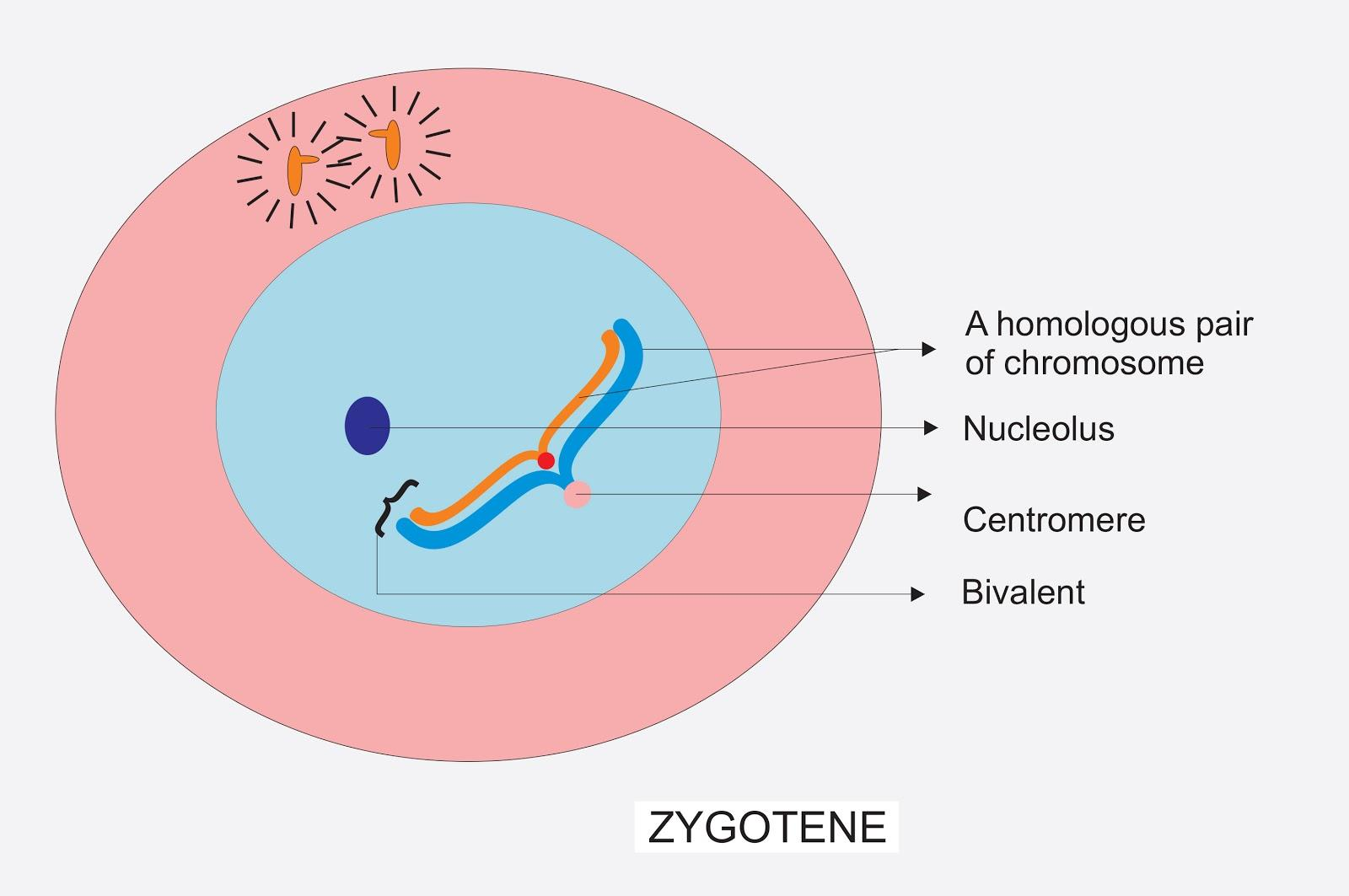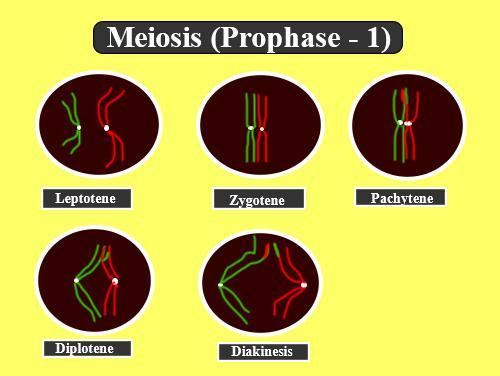




Learn About the Role of Synapsis and Chromosomal Pairing in Genetic Variation
Zygotene is the second stage of prophase I in meiosis, where homologous chromosomes begin pairing in a process called synapsis. This pairing is crucial for genetic recombination, ensuring genetic diversity in offspring. This stage is followed by pachytene, where crossing over occurs.
This page aims to explain the significance of zygotene in meiosis, its role in genetic inheritance, and how it contributes to variation in living organisms. Understanding zygotene is essential for genetics, evolution, and cell biology, as it forms the foundation for sexual reproduction and genetic diversity in species.
What is Zygotene?
Zygotene comes under the second stage Prophase-1 of meiosis. It is followed by the stage of leptotene, where chromosome uncoiling and condensing occurs. Homologous chromosomes (one from the mother and one from the father) come together and pair in the zygotene phase.
Synapsis is a very specific and precise process. At the end of the chromosome, the synapsis process may begin and progress towards the centromere or vice-versa. Synapsis occurs at multiple points in the random form. A protein complex known as the synaptonemal complex joins the paired chromosomes together.

Synapsis
The pairing of two homologous chromosomes that occurs during meiosis is synapsis (also called syndesis). It enables the matching of homologous pairs and possible chromosomal crossover between them prior to their segregation. This occurs during prophase I of meiosis.
Their ends are first attached to the nuclear envelope once homologous chromosomes synapse.
Then, aided by the extranuclear cytoskeleton, these end-membrane complexes migrate until matching ends have been paired. Then the chromosome's intervening regions are brought together and connected through a protein-RNA complex called the synaptonemal complex.
During meiosis, autosomes undergo synapsis and are kept together by a protein complex called the synaptonemal complex along the entire length of the chromosomes. Sex chromosomes often undergo synapsis, but only one end of each sex chromosome contains the synaptonemal protein complex that binds the homologous chromosomes together.
Meiotic Prophase
Sexually reproducing species use a process to produce gametes, such as sperm or egg cells, and this process is called meiosis. It is a special form of cell division of germ cells. It requires two-division rounds that eventually result in four cells with just one copy of each paternal and maternal chromosome.
Meiosis usually has two cycles of segregation of chromosomes and thus twice undergoes prophase, leading to prophase I and prophase II. In all meiosis, Prophase I is the most complex stage because homologous chromosomes have to pair and exchange genetic information. The mitotic prophase is very similar to Prophase II.

Prophase I
Prophase I consists of five stages: leptotene, zygotene, diplotene, pachytene, and diakinesis. In contrast to the events that occur in mitotic prophase, during these stages, other important events take place, such as the fusion of homologous chromosomes as well as the reciprocal sharing of the genetic material between these homologous chromosomes. Prophase I occurs at various speeds that depend on species and gender.
Lapotene: Chromosomes begin to condense in the first stage of Prophase I, leptotene (from the Greek for "delicate"). Every chromosome is found to be in a haploid state and comprises two sister chromatids, but the sister chromatids' chromatin is not yet sufficiently condensed to be microscopically resolvable. Homologous regions start to interact with each other within homologous chromosome pairs.
Zygotene: Both maternally and paternally derived chromosomes have met their homologous partner in the second step of prophase I, zygotene (from the Greek for 'conjugation'). Then the homologous pairs undergo synapsis, a mechanism by which the synaptonemal complex aligns the corresponding genetic information regions with the non-sister chromatids of homologous chromosome pairs, maternally and paternally derived. The synaptonemal complex-bound paired homologous chromosome is referred to as bivalents or tetrads. Sex chromosomes (X and Y) do not completely synapse since they are homologous only to a small region of the chromosomes. In the nucleus, the nucleolus shifts from a central to a peripheral position.
Pachytene: At the end of synapsis, the third step of prophase I, pachytene (from the Greek for 'thick'), begins. Chromatin gets sufficiently condensed such that in microscopy, chromosomes can now be resolved. On the synaptonemal complex of bivalents, structures called recombination nodules are formed. In an event known as crossing-over or genetic recombination, these recombination nodules promote genetic exchange amongst non-sister chromatids of the synaptonemal complex. There can be several recombination instances on each bivalent. An average of 2-3 events happens on each chromosome in humans.
Diplotene: The crossing-over is done in the fourth step of prophase I, diplotene (from the Greek for 'twofold'). A total collection of genetic information is preserved by homologous chromosomes, but the homologous chromosomes are also of mixed maternal and paternal descent. Visible junctions are also called chiasmata to keep the homologous chromosomes together as the synaptonemal complex dissolves in areas where recombination occurred. Meiotic arrest occurs in many species at this point.
Diakinesis: Diakinesis is the fifth and final step of prophase I where complete chromatin condensation occurs. At this stage, four sister chromatids can be seen with microscopy in bivalents. As the meiotic prophase ends with the spindle apparatus beginning to develop, and the nuclear membrane beginning to break down, the remainder of the phase resembles the early stages of mitotic prometaphase.
Conclusion:
Zygotene is a critical stage in prophase I of meiosis, where homologous chromosomes pair through synapsis, setting the stage for genetic recombination. This precise alignment ensures proper chromosome segregation and contributes to genetic variation, which is essential for evolution and inheritance. Understanding zygotene helps in studying genetics, cell division, and reproductive biology, providing insights into how traits are passed across generations.
Essential Study Materials for NEET 2025
FAQs on Understanding Zygotene -The Chromosomal Pairing Stage in Meiosis
1. What is the Amount of DNA Synthesized During Zygotene?
0.4% of DNA is synthesised in the zygotene stage. During zygotene, very little DNA is replicated, while most are replicated in the S process. In chromosomes, this unreplicated DNA helps to keep the chromosomes together after zygotene.
2. Give One Characteristic of the Zygotene Stage.
Chromosomes begin pairing and are called homologous chromosomes during meiotic prophase I zygotene. A bivalent is considered as a pair of homologous chromosomes which do lie together. The synaptonemal complex is considered a complex formed by a pair of synapsed homologous chromosomes and is one of the characteristics of the zygotene stage of prophase I.
3. What is zygotene?
Zygotene is the second stage of prophase I in meiosis, where homologous chromosomes pair up through a process called synapsis.
4.What happens during the zygotene stage?
In zygotene, homologous chromosomes start aligning and form the synaptonemal complex, which helps in pairing and preparing for genetic recombination.
5.What is the significance of synapsis in zygotene?
Synapsis ensures that homologous chromosomes are properly aligned, allowing for crossing over in the next stage, which leads to genetic variation.
6. How does zygotene differ from leptotene?
In leptotene, chromosomes start condensing but remain unpaired, while in zygotene, homologous chromosomes begin pairing through synapsis.
7. What is the role of the synaptonemal complex in zygotene?
The synaptonemal complex is a protein structure that stabilizes chromosome pairing and facilitates genetic recombination during meiosis.
8 . What comes after the zygotene stage?
Zygotene is followed by pachytene, where crossing over (exchange of genetic material) occurs between homologous chromosomes.























